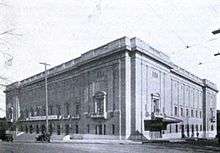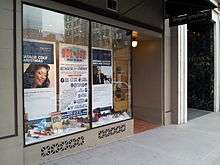Oregon Symphony
| Oregon Symphony | |
|---|---|
| Orchestra | |
 The Arlene Schnitzer Concert Hall. | |
| Founded | 1896 |
| Location | Portland, Oregon |
| Concert hall | Arlene Schnitzer Concert Hall |
| Principal conductor | Carlos Kalmar |
| Website |
www |

The Oregon Symphony is an American orchestra based in Portland, Oregon. Founded as the Portland Symphony Society in 1896, it is the sixth oldest orchestra in the United States, and oldest in the Western United States. Its home venue is the Arlene Schnitzer Concert Hall in downtown Portland's Cultural District.
History
Its first concert was held at the 1,700 seat Marquam Grand Theatre on October 30, 1896, with W. H. Kinross conducting 33 performers. Included on the first program was Joseph Haydn's Surprise Symphony.
By 1899 the orchestra was performing an annual concert series (with occasional lulls), and in 1902 the first tour of the state was made. Orchestra members shared ticket revenues as a cooperative, and elected their conductors in the early years.
Royal Academy of Music trained musician Carl Denton was a major force in helping the Portland Symphony Society enter a new era. The board of directors was elected and a manager hired. Orchestra members continued to elect their conductors for the 1911/1912 season. The order of conductor and concertmaster rotation was determined by drawing lots. Musicians were from the dance and theatre orchestras of Portland. Following fourteen rehearsals, the first concert of this new-era Portland Symphony Orchestra was held at 2:30 p.m. November 12, 1911 at the newly opened Heilig Theater at SW Broadway and Taylor street. Mose Christensen conducted 54 performers in Dvorak's Symphony No. 9 in E minor and other works. Carl Denton conducted the second concert on December 17, 1911 followed by John Bayley on January 21, 1912 and Harold C. Bayley (the son of John Bayley) on March 3, 1912. Mose Christensen completed that season with the fifth concert on April 14, 1912. Harold Bayley, Carl Denton, and Mose Christensen also served as rotating concertmasters when they weren't conducting. The entire budget was made up of door receipts, which were divided equally except that the conductor received two shares. For the first concert, each musician received $1.45.

The orchestra continued to elect rotating conductors as leaders until the symphony board appointed Carl Denton as the first permanent conductor on August 18, 1918. The orchestra began holding its concerts at Municipal Auditorium, later renamed Civic Auditorium. Under Denton, ticket sales increased and the number of musicians were therefore increased.
Theodore Spiering, who had guest conducted the orchestra, was the next appointed conductor. Spiering was unable to begin his first season as conductor because of his untimely death in Munich (where he was searching for new scores for the orchestra). At the suggestion of artist manager Arthur Judson, the symphony board next appointed Dutch conductor Willem van Hoogstraten. Hoogstraten's first concert, on November 9, 1925, included Tchaikovsky's Symphony No. 4, performed by 69 musicians. Some of the Dutch conductors concerts were nationally broadcast on the radio. The orchestra was now recognized as one of the fifteen largest in the nation.
During the Great Depression, the Portland Symphony Society nearly closed in 1931.[1] A mimeographed letter to society members pleading for donations by Isabella Gauld kept the society open.[1] The threat of war and a budget deficit of nearly $20,000 caused the board to suspend operations in 1938. A farewell concert on February 28, 1938 featured Hoogstraten conducting the symphony and chorus in Brahms’ German Requiem.
There was no regular symphony season between 1938 and 1947. There were some concerts however, some under well-known guest conductors. There was also a WPA Portland Federal Symphony Orchestra for one season of concerts held at the Neighbors of Woodcraft auditorium, beginning in January 1939. Misha Pelz, who had conducted the Portland Federal Symphony Band, was the regular conductor and Leslie Hodge guest conducted for two concerts.
An orchestra billed as the Portland Philharmonic, with 40 musicians provided by the federal music project, held its debut concert on January 16, 1940 with Hodge conducting. Hodge announced his resignation in September 1940 and Charles Lautrop succeeded him as conductor. Directors suspended operation of this orchestra on December 30, 1940.
Reorganization
The Portland Symphony orchestra was reorganized in 1947 as a permanent professional group. A well-known American conductor, Werner Janssen, was engaged for two seasons (1947–1949), followed by James Sample (1949–1953). Guest conductors were engaged for the 1953-1955 seasons (in lieu of a regular conductor) including Carlos Chávez, Enrique Jordá, Dimitri Mitropoulos Thomas Schippers, Boris Sirpo, Russell Stanger, and Igor Stravinsky. Theodore Bloomfield was one of these guest conductors, and he also became the next regular conductor (1955–1959). The Italian conductor Piero Bellugi (1959–1961) became only the second non-American conductor since Hoogstraten. Each of these early conductors in the reorganized symphony era left after only a few years because the orchestra lacked financial backing. Bellugi also refused to return for a scheduled guest conductor engagement in the spring of 1962 citing the programs lacked sufficient scope for his talents.
Jacques Singer an American conductor led the orchestra from 1962–1972.[2] During 1965–1967, the orchestra performed in a leased 1927 movie house, the Oriental Theatre on SE Grand Avenue between Morrison and Belmont Streets, while the Civic Auditorium was being rebuilt. In July 1966, a $1.25 million Ford Foundation grant was announced. In August 1967, the name was changed to the Oregon Symphony Society (and Orchestra) to reflect the wider scope of the orchestra.[3] In the fall of 1970 the symphony board and musicians' union successfully negotiated the first two-year contract. The musicians, seeking better wages, joined the International Conference of Symphony and Opera Musicians (ICSOM) in 1971.
In 1970, the Oregon Symphony Pops began a longstanding relationship with their conductor Norman Leyden who was appointed associate conductor in January 1974. Leyden, who retired in May 2004, was honored with the lifetime title Laureate Associate Conductor.
In 1973 Lawrence Leighton Smith was selected as conductor, the first conductor born in Portland to lead the orchestra. He led the orchestra until 1980.[2]

James DePreist, one of the first African-American conductors,[4] became the orchestra's conductor in 1980. In 1984, the orchestra went from part-time to full-time. Also in 1984, the orchestra moved from Civic (now Keller) Auditorium to the Arlene Schnitzer Concert Hall. The orchestra was now able to rehearse in the same space they performed their concerts. James DePreist's arrangement of the theme for The Cosby Show was recorded by the orchestra in May 1988 for use in the fifth season of that television program. The first out-of-state tour outside of the Pacific Northwest was made in September 1992, to the Hollywood Bowl at the invitation of the Los Angeles Philharmonic.
Although there were labor disagreements and brief lockouts by management in 1986 and 1989, in September 1996 the 86 musicians voted unanimously to strike for the first time. Money was the issue in negotiating a new contract. Five rehearsals and six concerts were canceled before a new four-year contract was negotiated before the end of September.
The orchestra's first Grammy nomination came in 2003. Principal percussionist Niel DePonte was nominated for best instrumental soloist performance with orchestra for Oregon composer Tomas Svoboda's "Concerto for Marimba and Orchestra", recorded by Albany Records in January 2000.
A 90-minute television special produced by CBS affiliate KOIN Channel 6 in honor of the Symphony’s Centennial featured DePreist and the orchestra in a performance of its signature work, Rachmaninoff’s Symphony No. 2 In E Minor, Op. 27, and was awarded a Northwest Regional Emmy in June 1997. It was produced by John Ray and directed by Richard Hammerstrom.
DePreist remained as conductor for 23 years. By the time he left in 2003, he had led the transformation of the orchestra from a small, part-time group into a full-time nationally recognized orchestra. During that period, the orchestra released 17 recordings. Peter Frajola, a principal violinist, who joined the orchestra in the 1980s, said the symphony took "phenomenal musical journeys" with DePreist. "Jimmy" as DePreist was known to locals, became a well known personality in the Portland community.[4] He was the Laureate Music Director of the Oregon Symphony until his death in 2013.[2]
Since 2003, the Uruguayan-born Carlos Kalmar has been the orchestra's music director. In April 2008, the orchestra announced the extension of Kalmar's contract as music director to the 2012-2013 season.[2]
Guest conductors
Among those who have guest conducted the orchestra are: Aaron Copland, Arthur Fiedler, Otto Klemperer, Yakov Kreizberg, Erich Leinsdorf, Dimitri Mitropoulos, Maurice Ravel, Miklós Rózsa, Igor Stravinsky, and John Williams.
Recordings and discography
The Oregon Symphony began recording for the Delos label in 1987. A collection entitled Bravura, includes works by Witold Lutosławski, Ottorino Respighi, and Richard Strauss. Recordings have continued, with releases also on the Koch and Albany labels. Sixteen compact discs were issued through 2005.
November 2011, the Oregon Symphony released Music for a Time of War, on the Pentatone label. Recorded at the Arlene Schnitzer Concert Hall in Portland, Oregon, with Carlos Kalmar conducting, the album features the program played at the orchestra's May 2011 Spring into Music Festival concert at Carnegie Hall. December 5, 2012, this album received two Grammy nominations: one for Best Engineered Album, Classical; and one for Best Orchestral Performance.[5]
Music directors
- 1909 David C. Rosebrook
- 1911 Carl Denton
- 1912 John Bayley
- 1913 George E. Jeffery
- 1914 Carl Denton
- 1915 John Bayley
- 1916 Waldemar Lind
- 1917 Mose Christensen
- 1918-1925 Carl Denton
- 1925 Theodore Spiering
- 1925-1938 Willem van Hoogstraten
- 1947-1949 Werner Janssen
- 1949-1953 James Sample
- 1955-1959 Theodore Bloomfield
- 1959-1961 Piero Bellugi
- 1962-1972 Jacques Singer
- 1973-1980 Lawrence Leighton Smith
- 1980-2003 James DePreist
- 2003–present Carlos Kalmar
Laureate conductors
- James DePreist, Laureate Music Director
- Norman Leyden, Laureate Associate Conductor
Concertmasters
- 1922-1924 Jno F.N. Colburn
- 1924-1927 Alf Keller
- 1927-1938 Ed Hurlimann
- 1947-1948 John Copin
- 1948-1949 Tibor Zelig
- 1950-1973 Hugh Ewart
- 1973-2003 Michael Foxman
- 2004-2007 Amy Schwartz Moretti
- 2007-2011 Jun Iwasaki
- 2012- Sarah Kwak
References
- 1 2 MacColl, E. Kimbark (1979). The Growth of a City: Power and Politics in Portland, Oregon 1915-1950. Portland, Oregon: The Georgian Press. ISBN 0-9603408-1-5.
- 1 2 3 4 David Stabler (12 April 2008). "Oregon Symphony conductor renews contract". The Oregonian. Retrieved 2008-04-22.
- ↑ "Symphony Statewide". The Oregonian. August 18, 1967. Section 1, p. 50.
- 1 2 DuBois, Steven (February 8, 2013). "Conductor, Juilliard emeritus James DePreist dies". Associated Press. Retrieved September 7, 2013.
- ↑ Stabler, David (5 December 2012). "Oregon Symphony nominated for a Grammy for 'Music For a Time of War'". The Oregonian. Retrieved 5 December 2012.
Sources
- "Conductor Backs Out of Guest Spot, Program 'Beyond His Dignity',?" Oregonian, April 11, 1962 (Bellugi is the conductor).
- Goodrich, Frederick W. "Nearly 70 Eventful Years of Orchestral Music". The Oregonian, November 3, 1935, page 11.
- Goodrich, Frederick W. "Oregon Orchestra Music, 1868-1932" Oregon Historical Quarterly, June 1932, pages 136-142.
- Long, Genevieve J. “Making `Good Music’: The Oregon Symphony and Music Director Jacques Singer, 1962-1971. Oregon Historical Quarterly, Spring 2008.
- Millard, Robert E. "The Birth of the Portland Symphony Orchestra". Aired on KPAM radio station on September 30, 1962.
- Noles, B. J. "Bayley Musical Library Donated for University Use". The Oregonian, June 12, 1968, section II, page 7.
- Programs of the WPA Portland Federal Symphony Orchestra 1938-1939
- Programs of the Portland Symphony Orchestra and Oregon Symphony 1896-
- Stabler, David. "Symphony, Musicians in Harmony on Contract", The Oregonian, September 25, 1996, page A1.
- Stabler, David. "Symphony Players Strike Today", The Oregonian, September 10, 1996, page B1.
- Wallin, J. L. "Half Century of Portland’s Symphony". The Oregonian, October 20, 1935.
External links
| Wikimedia Commons has media related to Oregon Symphony. |
- Oregon Symphony (official website)
- Oregon Symphony discography